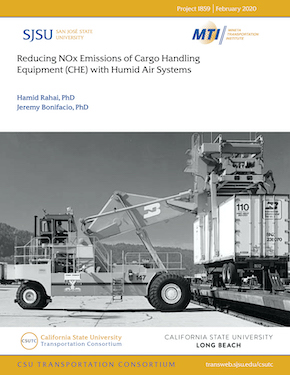- 408-924-7560
- mineta-institute@sjsu.edu
- Donate
Reducing NOx Emissions of Cargo Handling Equipment (CHE) with Humid Air Systems
The authors designed and tested a humid air system (HAS) for reducing NOx emissions of an LPG-powered forklift. The HAS uses distilled water and heat from the exhaust to generate steam that is injected into the intake air of the engine to increase humidity and thus achieve NOx reduction. Field tests with HAS have shown 2.2 ppm of NOx reduction with each percent increase in humidity of the intake air. A provisional patent based on the developed system has been filed.
HAMID RAHAI, PhD
Dr. Hamid Rahai is a professor in the Departments of Mechanical and Aerospace Engineering & Biomedical Engineering and is Associate Dean for Research and Graduate Studies in the College of Engineering at CSULB. He has taught various classes at the undergraduate and graduate levels in the areas of fluid dynamics, thermodynamics, heat transfer, instrumentation, numerical methods, and turbulence. He has supervised over 65 MS theses and projects and PhD dissertations and has published more than 90 technical papers. He has received in excess of 8 million dollars in grants and contracts from the National Science Foundation, Federal Highway Administration, California Energy Commission, California Air Resources Board, Port of Los Angeles, Caltrans, Boeing Company, Southern California Edison, Long Beach Airport, and Long Beach Transit, among others. He has been granted a patent for the development of a high-efficiency vertical axis wind turbine (VAWT) and another patent with Via Verde Company on wind turbine apparatuses. He also has pending patents related to a new diagnostic system for lung diseases using CFD, a new conformal vortex generator tape for reducing wingtip vortices, and pending patents based on previous MTI-funded research into reducing drag of trailer trucks with rotating cylinders as well as the current study, reducing NOx emissions of gas-powered engines using a humid air system. For the past 26 years, he has been a consultant to local energy and aerospace industries. Dr. Rahai is the recipient of several scholarly and creative activities awards (RSCA), including the 2012 CSULB Impact Accomplishment of the Year in RSCA Award, the 2002–2003 CSULB Distinguished Faculty RSCA Award, and the 2004 Northrop Grumman Excellence in Teaching Award. In 2014, Dr. Rahai received the Outstanding Engineering Educator Award from the Orange County Engineering Council in California, and in 2019 he was inducted as a senior member of the National Academy of Inventors (NAI).
JEREMY BONIFACIO, PhD
Dr. Jeremy Bonifacio is a lecturer and a research associate at the Center for Energy and Environmental Research & Services (CEERS) in the College of Engineering at California State University, Long Beach. He has been involved in various projects at CEERS related to emission control technologies and mitigations along with various aerodynamics and indoor air quality projects. He is a co-owner of two provisional patents and author of ten technical publications.
-
Contact Us
San José State University One Washington Square, San Jose, CA 95192 Phone: 408-924-7560 Email: mineta-institute@sjsu.edu






